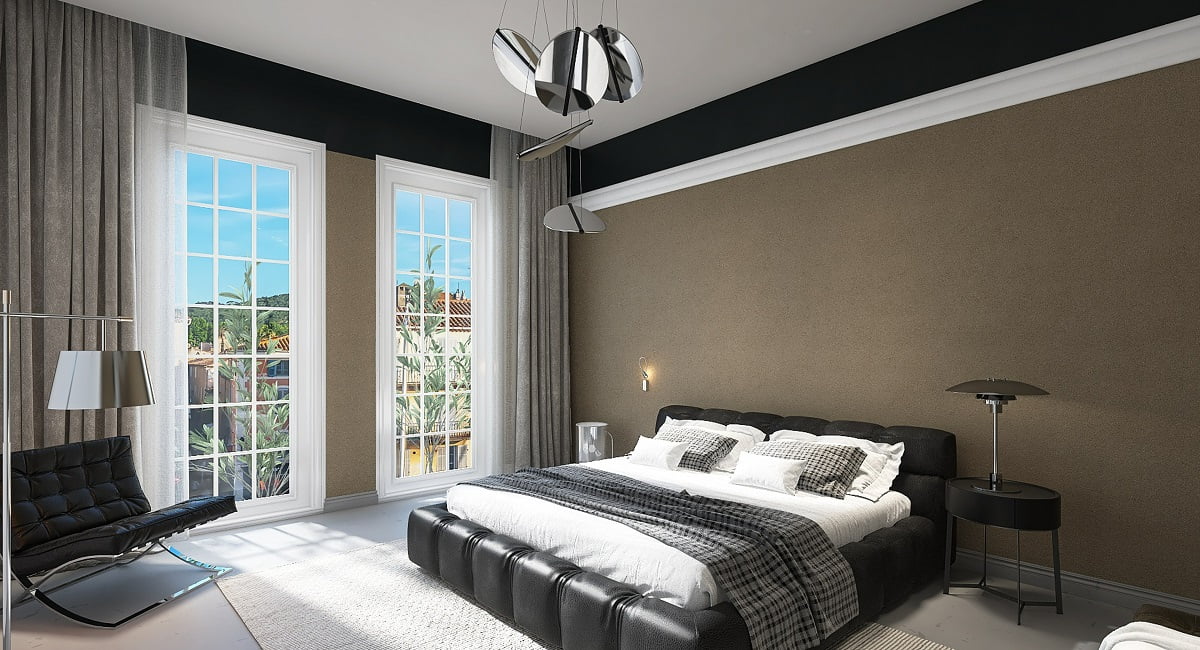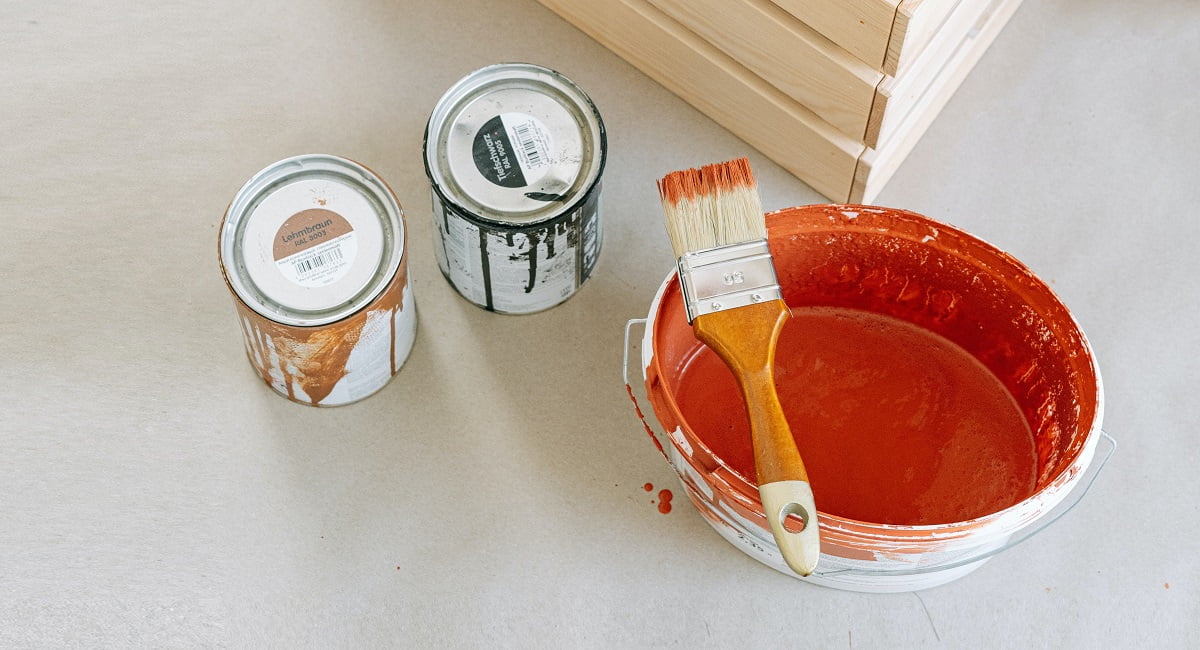Do you want to give your home a fresh new appearance? Then you can consider giving it a fresh new coat of paint.

Painting your home from time to time keeps it looking new. Although there are certain things that you need to keep in mind while undertaking a home painting project, which includes purchasing different paints for your walls and ceiling.
If you’re not a DIYer, you might feel confused with the above statement. The ceiling is just like the other walls in your house. So, what is the difference between regular and ceiling paint anyway?
Well, for starters, ceiling paint is thicker than wall paint, and its composition is slightly different. But there are more differences besides these, which is what we have addressed in this brief guide. So, if you are suddenly feeling curious about it, then allow us to satisfy that curiosity.
Let’s get going, then!
What Is Ceiling Paint?

When we were conducting our own research on this topic, one of the first questions that popped into our minds was this one. And that’s why we have discussed a little about ceiling paint first in this section. Once we are done, we can get to addressing the differences between the two paints.
If we were to answer the above question simply - ceiling paint is a special type of paint that is best suited for painting your ceiling. Well, obviously, the name makes that clear enough, so you could make it out on your own. But there’s more to it than just that; allow us to elaborate further.
Ceiling paint is a type of paint that is highly viscous and dense so that it doesn’t drip from the ceiling. Typically, ceiling paint is made from latex resins, which are responsible for its thickness and viscosity.
What’s more, it is designed to give your ceiling a flat paint sheen. Its texture and chemical composition can resist staining and discoloration when exposed to dirt, dust, or smoke. Furthermore, it can resist stains and water patches caused by roof leaks. And as a bonus, a good quality ceiling pain will prevent the growth of mold and mildew.
On the flip side, you do not get too many ceiling paint color options. So, if you want to apply a fresh coat, then be advised - you’ll get only a handful of shades to choose from.
How Is Ceiling Paint Different From Regular Wall Paint?
Now that you know what ceiling paint is, it’s time to address the main question. In this regard, there are quite a few points of difference between the two paints, which have been described below.
1. Composition
There are some obvious differences between the composition of ceiling paint and wall paint or interior paint. For starters, ceiling paint is usually latex-based, while conventional wall paint is acrylic.
Ceiling paint uses water as a solvent, which gives it a dense texture, similar to latex resins. On the other hand, due to most wall paints being acrylic, they use different chemical solvents and thinners.
There are some instances where wall paints are water-based. But even in such cases, they do not have the density and texture of ceiling paint.
2. Viscosity
The most obvious point of difference between these two paints is their viscosities. Ceiling paint is highly viscous, while typical wall paint is thinner and less viscous in comparison.
This can be explained in light of the previous point of difference. Due to the water-based nature of ceiling paint, it is thicker, which, in turn, makes it more viscous. In contrast, the presence of thinning solvents makes regular wall paint more fluid.
Because of its high viscosity, it does not drip as much as wall paint. But, it is comparatively less elastic than wall paint, which means it does not contract or expand as easily.
3. Finish
If you have painted your home before, then you know that regular wall paints come in a variety of finishes. You have satin wall paint that has a subtle shiny finish. Then there is the eggshell finish, which is slightly less polished compared to the satin paint finish. It has an appearance that is similar to an eggshell, hence the name.
You also have semi-gloss paint that is comparatively shinier than satin paint. And if you want a higher gloss, you can opt for high gloss paints for your walls, which will give them a shiny finish. Or, simply go with matte finish paint if you don’t prefer shiny walls.
On the contrary, ceiling paints are only available in a flat finish. If you are wondering why that is, then the answer is simple. Flat paints are non-reflective, which helps them conceal stains and imperfections better. Besides, the flat appearance of this paint helps minimize the reflection of natural light, as a reflective ceiling may be too bright to look at. It's important to note that while textured wall paints might offer minor acoustical benefits, ceiling paint does not provide such improvements. If sound reduction is a concern, you should consider exploring alternative soundproofing materials and strategies.
4. Durability
Ceiling paint can be considered to be durable, as it does not become stained or discolored as easily. And since it is thicker, it is less prone to flaking or chipping.
Wall paint is comparatively not as long-lasting, especially if it has a glossy finish. In fact, as the paint gets glossier, it becomes less durable. The polished surface of such paint is not so great at preventing stains and discolorations. And they are more prone to chip off from the walls.
5. Coverage
Ceiling paint has a considerably greater coverage than wall paint. Usually, when using ceiling paint, one coat is enough to give you a uniform color. However, with conventional wall paint, you need to apply two or three coats to get uniform coverage.
6. Color Choices
Another point of difference between these two paint types is the color choices. With wall paint, you get a relatively diverse selection of colors but the same cannot be said for ceiling paint. This paint generally is available in a flat white color, with some occasional lighter shades.

Can You Use Wall Paint On A Ceiling?
So, now you know what makes ceiling paint different from conventional wall paint. The question that now arises is - can you use regular wall paint for painting ceilings? The answer is yes, you can, but there are some limitations to it.
First off, you will have a lot of drip spots on your ceiling if you use wall paint on it. On top of that, the paint will spatter all over your room, which can create quite a mess. As a result, the cleanup after you are done will be a major headache.
However, there are ways by which you can manage these problems. If you use a paint sprayer instead of a brush or roller, there will be fewer drips. It will also eliminate the issue of paint splattering all over your room. But using a sprayer can be a lot slower and more inconsistent than a roller or a brush.
Conversely, you could minimize the mess by undertaking extensive prep work. Start by covering the whole room with a drop cloth to protect it from drips and spattering. Or, you could clear out the room by removing all of the furniture and fittings before starting the paint job.
On that note, the above steps will make the work significantly more inconvenient and time-consuming. So, it is simpler just to use ceiling paint instead.
Can You Use Ceiling Paint On Walls?
As a counter to the above question, you may now ask - can ceiling paint be used for painting walls? Simply put, you can definitely use ceiling paint on your walls. It might even be advantageous in some cases, thanks to the viscosity and thickness of ceiling paint.
Moreover, if you use it to paint walls, your paint job will be a lot less messy than using regular wall paint. That’s because you will have considerably fewer drip spots on your wall.
Also, it is far easier to fix noticeable drip spots with ceiling paint. All you have to do is roll over these drips once, and the thickness of the paint will take care of the rest.
However, there is one downside to using ceiling paint for your walls. You will not have a lot of color options to choose from. And due to its finish, all of your walls will have a flat sheen. So, if you are fine with that, then, by all means, go ahead and use it.
Otherwise, use ceiling paint as a primer to get most of its benefits without being limited to a few colors and finishes.
What Are The Best Scenarios To Use Ceiling Paint?
There are certain scenarios where using ceiling paint is more favorable than using wall paint. These include areas that are more vulnerable to dust and stains, such as basements, stairwells, and closets. Here’s where you can color both the ceiling and the walls with the same ceiling paint.
It can also be used when you want a uniform look for your entire room. In that case, your walls and ceiling will have the same sheen and coloration.
Can You Mix Ceiling Paint With Wall Paint?
There is no rule against mixing these two paints together. So, if you want to experiment a little bit, you can do so. But be advised - the resultant paint mixture might not be as consistent or uniform as its constituents.
For instance, if you mix glossy wall paint with flat ceiling paint, the paint that you get might have a peculiar finish. Moreover, the difference in composition of these two paints may not create a very stable mixture.
The best method to mix these two paints together is to apply them separately. You can use ceiling paint as an undercoat or a primer and apply a topcoat of wall paint as the finishing. This indirect method of mixing may give you better results than blending them both directly.
Is Flat White Paint The Same As Ceiling Paint?
Based on our previous discussions, you may think that ceiling paint is the same as flat white paint. However, that is not the case, as there are some obvious differences between them.
Yes, most ceiling paints are white, but that doesn’t apply to all of them. You do get a few color choices, even though they are pretty limited. Besides, flat white paint is not as viscous as ceiling paint, which is further proof that they are not the same.
That said, there are certain similarities between them. For starters, both of them have a flat appearance, and they are good at concealing or covering up stains and other imperfections. But those are the only similarities, and since they are not that significant, it is safe to say that these two paints are different.

Difference Between Ceiling Paint And Regular Paint Final Words
That’s all we have to say about the differences between ceiling paint and regular paint. While in some cases, they can be used interchangeably, for the most part, they are two distinctive types of paint.
So, keep these differences in mind the next time you want to paint your home. It will help you decide better on which paints to buy for your interior walls and your ceiling. And it will make the paint job a whole lot more convenient.
It is time for us to wrap up this guide. In the meantime, check out our other article on ceiling paint vs wall paint for more head on comparisons. We will be back with more informative guides in the future.
Until then, we bid you farewell!
